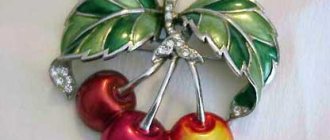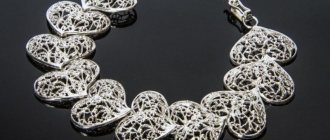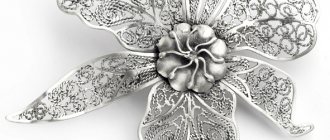The famous Ipatiev Chronicle brings to us the story of the marvelous creations of Russian jewelers who decorated their products with enamel - a composition of colored glassy powder hardened after firing, which made it possible to achieve an extraordinary visual effect. This technology came to Rus' from Byzantium, where it appeared in the 6th century. Nowadays, the ancient word enamel has gone out of circulation, giving way to the currently used term - artistic enamel.
What is decorative enamel?
Before we start talking about what the artistic technique called “cloisonne enamel” is, let’s take a closer look at the description of this composition itself, used by jewelers and masters of decorative and applied arts. As mentioned above, enamel is a powder obtained by grinding colored glassy plates.
Moistened with water and transformed into a solid, pliable mass, the composition is applied to cells made on the surface of the product. The next stage of work is firing. It is produced either in a furnace or with a special gas or gasoline burner. Under the influence of high temperature (from 700 to 900 °C), the glassy mass hardens and takes on its unique appearance.
Features of the composition of enamels
Based on spectral analysis data, the researchers found that the qualitative composition used to make enamels in the 16th–19th centuries was very different from modern samples .
Thanks to these studies, trace amounts of tannin, vanadium, thallium, molybdenum, silver, gold, antimony, manganese, zirconium, magnesium, copper, etc. were identified.
Most likely, these substances got into the coating due to contamination of the reagents: only a small part of these components was introduced to achieve a certain effect.
Today, technologies make it possible to more accurately predict the result of the introduction of a particular pigment substance. The level of technology makes it possible to operate with hundredths and thousandths of concentration, which opens up incredible scope in the palette of shades.
Most enamels before the 19th century were obtained as a result of experiment. Now experimental work is being carried out in the field of obtaining new shades.
Thus, employees of the VNII Yuvelirprom developed and introduced into production 12 new shades .
Features of working with enamel
Depending on the composition of the crushed glassy mass, the temperature, and the duration of firing, the resulting enamel can have varying degrees of transparency or be completely opaque - dull. This opens up wide creative possibilities for the master, as it allows him to achieve a wide variety of effects.
The range of techniques used in works of this kind is very rich, and one of them is cloisonné enamel. Jewelry made using it is not widespread and is considered elite. The reason is the complexity of their manufacture and the impossibility of mechanizing the production process. Each item is a unique work of authorship. If we also consider that noble metals are often used in work, their high price and low availability become clear.
How is cloisonne enamel created?
First of all, on the gold, silver or cupronickel (less often copper or steel) surface, which is the basis of the composition, the outline of the future design is engraved, and sometimes cut through. Then metal partitions are soldered along its edges, the thickness of which rarely exceeds one millimeter. These partitions, which give the name to the described type of enamel technique, form both closed and open cells, which are filled with a still liquid and viscous multi-colored mass.
After the enamel hardens during the firing process, the product is ground and polished. This is done in such a way that the surface of the partitions and enamel creates a single plane. The technique of cloisonné enamel is significantly complicated by the fact that during firing the layer of material shrinks and becomes lower than the partition. As a result, you have to replenish the cells and re-fire the product. Depending on a number of technical factors and the artistic intention of the author, firing can be repeated from five to one hundred times.
Unique products and consumer goods
It should be noted that the inability to influence the processes occurring in enamel when exposed to high temperatures determines the originality and uniqueness of each product. It is almost impossible to achieve the same effect twice, so each piece made using this technique is unique.
Cloisonné enamel is not the only enamel technique in the arts and crafts. Along with it, the so-called excavation is also widely used. It differs from the septal one in that the glassy composition is filled not with the cells formed by soldered partitions, but with specially made recesses, the shape of which corresponds to the lines of the drawing. In modern jewelry production, stamped blanks or those made by casting are usually used for this purpose. In the same industry, imitation cloisonné enamel is also used in the manufacture of consumer goods.
Stained glass window effect
Cloisonne enamel also has one more variety. It is called stained glass or window enamel. This technique is characterized by the fact that it does not use a metal base. It got its name because the products made on its basis resemble stained glass windows in appearance. They are completely transparent, and light, penetrating through the glassy mass, creates the illusion of colored stained glass framed by metal.
Products made using this technique are extremely beautiful. The metal frame, filled with enamel, looks like fine lace made of gold, silver or copper. It is made by sawing or mounting and then soldering parts made from wire twisted in a special way. Colored enamel filling the gaps between the partitions creates an indescribable play of light.
Famous examples
Fieschi-Morgan Stavrotheque
Crown of Monomachos - early 11th century
Fieschi-Morgan Staurotheke is an example of Byzantine enameling dating to the early 9th century, although some suggest a date of creation as early as 700. It was quite possibly made in Constantinople, although there is controversy surrounding its origin. some suggest it was done in Syria due to inconsistencies in the Greek letters. It is currently in the Metropolitan Museum of Art. The Fish Morgan stavrotheque is believed to have belonged to Pope Innocent IV and was brought west by the Fieschi family during the Crusades. The lid of the box depicts Christ on the crucifixion, a style not commonly seen in Byzantine art until the late 6th century and remaining unusual throughout the period. The work is not particularly refined, suggesting that the creator may not have been familiar with the work of the cloisonne elite.
Holy Crown of Hungary
Enamel of the Archangel Michael from the Holy Crown of Hungary - 11th century
The Holy Crown of Hungary, also known as the Crown of St. Stephen, has been used as the coronation crown of Hungary since the year 1000, when the Hungarian Royals introduced Christianity to the country. It contains mainly Byzantine enamel, originating from Constantinople, although it has not been proven that they were originally created for this purpose. The enamels are fixed around the base, and several plaques are attached on top. One enamel depicts Christ seated on the imperial throne and giving a blessing. Another enamel, located on the reverse side of the crown, depicts a bust of Emperor Michael VII Ducas (1071-1078) next to another plaque depicting his son Constantine. The Hungarian king Geza I (1074-1077) is also depicted, although he does not wear a halo like Michael VII Ducas or Constantine, indicating his lower status than the Byzantine emperors.
Beresford Cross of Hope
The Beresford Hope Cross is a pectoral cross intended for use as a shrine. On the one hand, Christ is depicted at the Crucifixion, and on the other, Mary prays between the busts of John the Baptist, Perter, Andrew and Paul. The dating is disputed, but most agree that it was made in the 9th century. The style is similar to the Stavroteca Fieschi-Morgana; the cloisonne portion of both is unrefined and stylistically careless compared to other examples. Inconsistencies in the Greek letters on the cross mean that the piece may not have been made in the Byzantine Empire, but in southern Italy, where the Lombards had their own metal workshops.
Jug of Saint-Maurice d'Agaun
Traditions of Chinese enamel
Chinese enamel occupies a special place in the history of decorative and applied arts. Cloisonne enamel, called clausane, was not an invention of the Chinese themselves, but came to them from France, but received a unique development due to local national traditions. From its original source, it inherited mainly the name, which comes from the distorted French word Cloison - “partition”. Before the appearance of this type of enamel technique in China, a recessed version of it was used.
The Beijing Palace Museum exhibits a wide variety of works of decorative and applied art, among which Chinese enamel stands out. Cloisonne enamel is represented mainly by products of the 15th century from the Xuande and Jingtai periods. This is no coincidence, since the period of the Ming dynasty, to which the mentioned rulers belonged, is considered the time of the greatest flowering of this field of art. Based on their own technologies, as well as those borrowed from Europe, Chinese craftsmen with extraordinary imagination decorated table and floor vases, cups, candy dishes, as well as a variety of lamps.
Cloisonne enamel in art
The history of using enamel goes back hundreds of years. Art developed in parallel in different countries, but the essence of the technology overlapped, despite local characteristics. The technology originated in Ancient Egypt , then through Byzantium it became widespread in Europe and reached Ancient Russia.
In Ancient Rus'
The first mention of Russian enamel was found in 1175 in the Ipatiev Chronicle .
Although enamel was originally used to decorate church items and icons, the evolution of the skill of Russian jewelers allowed the technique to acquire an indescribable flavor. Interesting! The most famous works of jewelry using cloisonné are Faberge eggs.
Unfortunately, the revolution of 1917 plunged the entire industry into decline for a long time. But today more and more craftsmen are turning to the technique of cloisonné enamel, achieving considerable success in this path.
Chinese enamel (Jingtailan)
In China, the emergence of this decorative and applied art dates back to the reign of the Jingtai Emperor, which is why the technique bears its name. China is the birthplace of the most beautiful products in this technique .
The finest designs are applied not only to jewelry, but also to screens, incense burners, bowls and chopsticks.
Interesting! Until the twentieth century, Jingtailan products could only be found in temples and the imperial palace.
However, in 1904 in Chicago at the international fair, Chinese cloisonné enamel deservedly took first place.
In Japan
The technique of working with enamel came to Japan from China and was called “sippo” . The main differences from mainland technology were a more muted color palette with fewer shades, a predominance of clear geometric patterns and a characteristic greenish background.
The second half of the 19th century became a renaissance period for sippo. With the invention of new types of durable, colorful compositions, the technique has become more diverse, although the classic subjects have not lost their relevance.
Byzantine enamels
The rapid development of science and art led to rapid technological progress, which allowed the emergence of such a phenomenon as Byzantine enamel in the 8th century.
For the first time in jewelry, such coating was used as an independent technique and artistic device , and not as a means of simulating precious stones.
It is the Byzantine technique that is considered classical. It served as the basis for the development of the art of cloisonne in medieval Europe and Ancient Rus'.
Georgian cloisonne enamel
Minanakri, without exaggeration, is the calling card of the state. The earliest examples of Georgian enamel date back 12 centuries .
Many early monuments were of a sacred nature and served to decorate churches. Unfortunately, evidence of the past has survived to this day in fragments. But since the 19th century, almost lost art has found a second life.
Artistic enamel from Georgia
Georgian cloisonné enamel is also held in special esteem by collectors and simply art lovers. Its earliest known examples date back to the 9th century, and they were made using the same technology that is used today. The art of Georgia, which is distinguished by its unique flavor and inexhaustible energy, embodies many European and Eastern traditions. That is why cloisonne enamel, the technology of which came to these parts from Western Europe, fit so organically into it. Here it was not only mastered, but also received further development, thanks to which many masterpieces of the national Georgian school appeared.
Byzantine enamel tradition
The Byzantines were the first artists to begin illustrating detailed miniature scenes in enamel. Several examples of early Byzantine enamel frames without glass flux have been discovered, and it has been hypothesized that they were used as teaching tools in workshops. Some partial enamel base plates have indentations marking the line to which the gold wire will be attached, indicating how the designs were outlined before soldering and enameling began. Because they were not cutting indentations into a base slab and then filling the hole with glass flux, Byzantine workers could also have used gold wire to create patterns that did not separate recesses from each other, resulting in a style that appears more like a drawn line .
Most Byzantine enamels known today date back to the 9th – 12th centuries. The period of iconoclasm 726-787. AD meant that most examples dating from the 8th century were destroyed due to their iconographic nature, although there are a few examples believed to have been made earlier. One of the earliest examples of Byzantine enamel work is a medallion, created in the late 5th or early 6th century, with a bust portrait of Empress Eudokia. The post-iconoclasm period saw a rise in the production of cult portraits, which lend themselves easily to the complex partition form developed by the Byzantines. Most of the enamel works known today have been in Western Europe since the early 13th century. All examples of enamel work that were still in Constantinople immediately before its destruction were lost or destroyed.
Enamel is considered a "minor art" due to its small size, which likely led to an increase in its use as decoration for small portable containers containing holy relics. According to this tradition, many enameled items found their way into the Western Empire through pilgrimages and gifts from the imperial family in Constantinople. The high cost and relatively small size of the enamel pieces meant that they were made for an aristocratic audience, most likely commissioned by the imperial family, often as gifts to other members of the royal family or to the churches they patronized. For example, there is evidence that Emperor Justinian II (565-578) sent enamels to Queen Radegund of France.
Another possible transfer of Byzantine enamel to the west was in the form of imperial marriages. In 927, German Emperor Otto II married the niece of Byzantine Emperor John I Tzimitsis, Princess Theophanes, and she supposedly introduced the imperial goldsmiths and enamellers to the German church. Many famous examples of Byzantine enamel - stavrotek
, relics containing fragments of the True Cross, which were highly prized in both the east and west, which is why many of them still survive in modern collections.
Probably, the stavroteke
was one of the first gifts sent from the East to the West.
There is some evidence that the Crusaders carried reliquaries before their military campaigns, as they were known to be given by Byzantine emperors. Fieschi Morgan Stavrotek
Enamel in times past and today
It is known that cloisonne enamel masters of past centuries used different components than their modern followers to obtain the composition they needed. One of the old recipes says that to prepare enamel you need one part of pure quartz sand, one part of boric acid and two parts of red lead. To give the composition the desired color, various pigments were used in the form of cadmium, cobalt or copper oxides.
In the 20th century, the enamel technique went beyond its traditional use and, in addition to decorative and applied arts, began to be used wherever it was necessary to create a durable and chemically resistant surface. Technical enamels appeared. Accordingly, the technology of their preparation has also changed.
Cloisonne enamel: master class
At the end of the article, we provide a detailed story on how to make a panel yourself, made using the septum enamel technique. This unique master class will allow everyone to try their hand at creating a work of decorative and applied art.
First of all, you need to take a copper plate of suitable size and thickness and anneal it until it turns red, and then cool it in water. This will give the material softness and protect it from deformation during further firing of the enamel itself. After this, the plate is wiped and thoroughly cleaned with sandpaper. You should not achieve a perfectly smooth surface, since slight roughness will contribute to a better connection between the metal and the enamel.
Septal enamel
Silver round pendant with enamel
I have always been fascinated by the beauty of jewelry made using the septum enamel . I have devoted many articles in this blog to the masters who create masterpieces in this technique, for example, jewelers from Scotland Barbara Macleod and Islay Spalding , from Poland Marta Rudnicka , from the USA Marianne Hanter , the dynasty of jewelers Macchiarini , and, of course, one of the world leaders in the field of enamel jewelry - the Frey Wille .
Set of necklaces, bracelets and earrings made of silver in enamel
“Enamel” itself has French roots (email), and in Russian it used to sound like enamel. Initially, enamel appeared as a substance that protected metals from oxidation and rust, but when they learned to add color to this composition, enamel became widespread among jewelers. The enamel itself is a powder of a glassy, fusible substance - lead salt.
Jeweler Gregory Pyra Piro pendant with septum enamel
Nowadays, enamel can be bought in separate bottles, and at home you can prepare the necessary composition for processing or decorating metal.
Beginning jeweler's kit for working with enamel
The picture shows an example of a modern beginner's enameller's kit, it costs $115 and includes 10 powders, 7 colored compounds, copper jewelry molds and a tool with instructions for use. The only negative is that you need a muffle furnace, and this is not a cheap pleasure, and not everyone can afford it.
Silver bracelet with black enamel
Methods of working with enamel:
Be sure to prepare the enamel in a porcelain mortar. The prepared solution is placed under glass to avoid dust. And you definitely need to sign the color, since powdered enamel After settling, the clear water is drained and the powder is used. If not all of the composition has been used, then it is filled with distilled water and stored in a tightly closed container. The powder is diluted to a dough and covered the surface.
Brooch with septum enamel
It is desirable that the metal has roughness for better connection. It is also necessary that the surface is perfectly clean. To do this, it is pickled, washed in running water and dried in sawdust. If water still remains on the surface, it means that the fat has not been completely removed and the enamel will not lie tightly.
Flower pendant with septum enamel
The enamel is applied to the required area and smoothed evenly. Next, the enamel is dried in air or a burner and then placed in a muffle furnace to heat it so that all the remaining water in the composition comes out. But you need to remove it gradually so that there is no sudden temperature change, otherwise cracks will appear and all the work will be in vain. Then the cooled layer of enamel is wiped with sulfuric acid and water, the solution is applied again and baked again. Sometimes this needs to be done a large number of times (from 2 to 6) so that the enamel is even with the metal partitions. The last layer is sanded with sandstone and fired again. For the septum enamel , it is necessary for the product to have an outer side, and also to cut plates from the same metal, and using tweezers, place them in the desired shape (for this it is good to have a sketch of your product on hand), bending them and connecting them to the main side as as tight as possible. You can use wax or solder to securely attach the partitions (jewelers recommend solder). Next, the compartments are filled with the desired enamel and baked, repeating the operation until the layers are aligned with the partition.
Pendant with a girl's face made using septum opal enamel technique
Enamel can be champlevé and septate, but jewelers often mix these techniques to create originality and beauty of the piece.
Silver fish - pendant made of septum enamel on silver
Enamel has been known since ancient times - Egypt, Greece, Rome and then all of Europe of a later period - Celts, Gauls, Vendas. Byzantium became the leader, and it was from there that the most beautiful examples came to us.
Egyptian gold necklace with septum enamel
Today's craftsmen have begun to use a combination of not only metals, but also plastic and clay with enamel, and instead of thin silver or gold stripes they use wire, mainly copper.
Silver ring with enamel in Indian style Here is a visual master class on making jewelry from silver with enamel.
Leen Loffeld 2010 Part 1,2
From drawing to installing partitions
The next step is to apply a design to the plate. This can be either your own composition or transferred from a book using tracing paper and carbon paper. To make the image clearer, the plate can be pre-coated with white gouache. Once the design is marked, it should be scratched using a steel scribe used in metalwork. After this, the plate is thoroughly washed and calcined again over fire.
To make partitions, it is recommended to use copper wire with a diameter of approximately 0.8 millimeters. It is first passed through rollers or simply flattened with a hammer. The resulting strip is glued edgewise to the plate, exactly repeating the line of the drawing. For this work, alcohol glue BF-6 is usually used.
Enameling and firing
To make panels, enamel should be used in the form of a powder mass. There are varieties on sale with the addition of gold or silver particles, which gives the product a more expensive and sophisticated look. The powder is diluted with water and the resulting mass is filled with the gaps between the partitions. For this purpose it is convenient to use a spatula and a brush. It is important that the enamel layer is evenly laid exactly along the height of the partitions.
The next step will require a drying oven. In it, the product is dried at a temperature of 60 ° C until the water completely evaporates from the enamel mixture. Upon completion of this process, the plate on a heat-resistant steel stand is placed in a muffle furnace and fired. If it is possible to regulate the temperature in the oven, then it is advisable to bring it to 850 ° C; if not, then heating should be continued until the surface of the product becomes glossy.
Types of enamels
There are different types of coatings based on various characteristics, one of which is color. Based on what pigment and in what concentration is added to the glass powder, the following are distinguished:
- yellow enamel;
- red;
- brown;
- blue;
- green;
- black.
Important! The final color of the product will depend on the concentration of the coloring pigment and its composition. Modern dyes make it possible to obtain a brighter and more saturated palette.
Based on optical properties, they are distinguished:
- translucent;
- transparent;
- opaque.
By processing temperature:
- Hot cloisonne enamel, which is baked in a muffle furnace at a temperature of 800 °C. This method is preferred by professional jewelers - real experts in their craft.
- Cold enamel, hardening at lower temperatures. This is a two-component polymer composition that, in fact, paints the product. To harden the coating, it is not high temperature that is used, but ultraviolet irradiation.
The final stage of work
After making sure that firing is completed, the plate is removed from the furnace using long tongs and, placed on a metal surface, pressed on top with a flat and even weight, the weight of which must be at least ten kilograms. In this form, the product cools down. Then the load is removed and the roughness is cleaned and scale is removed using a file.
Cloisonné enamel is not an easy technique, and the artistic qualities of the product may turn out to be unsatisfactory the first time. In this case, you can add the required amount of enamel to the cells and repeat the firing, but this can be done no more than four times, since with a larger amount this type of enamel becomes discolored.








